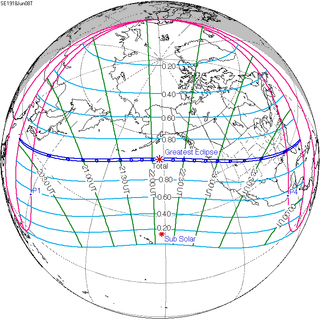Solar eclipse of June 8, 1918
| Solar eclipse of June 8, 1918 | |
|---|---|
| Type of eclipse | |
| Nature | Total |
| Gamma | 0.4658 |
| Magnitude | 1.0292 |
| Maximum eclipse | |
| Duration | 143 s (2 min 23 s) |
| Coordinates | 50°54′N 152°00′W / 50.9°N 152°W |
| Max. width of band | 112 km (70 mi) |
| Times (UTC) | |
| Greatest eclipse | 22:07:43 |
| References | |
| Saros | 126 (42 of 72) |
| Catalog # (SE5000) | 9324 |
A total solar eclipse occurred at the Moon's descending node of orbit between Saturday, June 8 and Sunday, June 9, 1918,[1] with a magnitude of 1.0292. A solar eclipse occurs when the Moon passes between Earth and the Sun, thereby totally or partly obscuring the image of the Sun for a viewer on Earth. A total solar eclipse occurs when the Moon's apparent diameter is larger than the Sun's, blocking all direct sunlight, turning day into darkness. Totality occurs in a narrow path across Earth's surface, with the partial solar eclipse visible over a surrounding region thousands of kilometres wide. Occurring 3.7 days after perigee (on June 5, 1918, at 8:40 UTC), the Moon's apparent diameter was larger.[2]
The eclipse was viewable across the entire contiguous United States, an event which would not occur again until the solar eclipse of August 21, 2017.
The Path
[edit]
The path of totality started south of Japan, went across the Pacific Ocean, passing northern part of Kitadaitō, Okinawa and the whole Tori-shima in Izu Islands on June 9 (Sunday), and then acrossed the contiguous United States and British Bahamas (today's Bahamas) on June 8 (Saturday). The largest city to see totality was Denver, although many could theoretically see it as the size of the shadow was between 70 and 44 miles (113 and 71 km) across as it traveled across America. The longest duration of totality was in the Pacific at a point south of Alaska. The path of the eclipse finished near Bermuda.[3]
Besides the path where a total solar eclipse was visible, a partial solar eclipse was visible in the eastern part of East Asia, northern part of Northern Europe, eastern part of Micronesia, Hawaii Islands, northeastern Russian Empire, the entire North America except the Lesser Antilles, and the northwestern tip of South America.

U.S. Observation team
[edit]
The path of the eclipse clipped Washington state, and then moved across the whole of Oregon through the rest of the country, exiting over Florida. The U.S. Naval Observatory (USNO) obtained a special grant of $3,500 from Congress for a team to observe the eclipse in Baker City, Oregon. The team had been making preparations since the year before, and John C. Hammond led the first members to Baker City on April 11.[4] The location was important, as it influenced the probability of cloud cover and the duration and angle of the sun during the eclipse. The team included Samuel Alfred Mitchell as its expert on eclipses, and Howard Russell Butler, an artist and physicist. In a time before reliable colour photography, Butler's role was to paint the eclipse at totality after observing it for 112.1 seconds.[5] He noted later that he used a system of taking notes of the colours using skills he had learned for transient effects.[5]
Joel Stebbins and Jakob Kunz from the University of Illinois Observatory made the first photoelectric photometric observations of the solar corona from their observing site near Rock Springs, Wyoming [6]
Observation
[edit]As the total eclipse approached, the team watched as clouds obscured the Sun. The clouds did clear, but during their most important observations the Sun was covered by a thin cloud; the Sun was completely visible five minutes later.[4] This was not unusual, as cloudy conditions were reported across the country, where the eclipse was also observed from the Yerkes Observatory, Lick Observatory, and Mount Wilson Observatory.[7]
Following the 1915 prediction of Albert Einstein's General theory of relativity that light would be deflected when passing near a massive object such as the Sun, the USNO expedition attempted to validate Einstein's prediction by measuring the position of stars near the Sun. The cloud cover during totality obscured observations of stars,[8] though, preventing this test of the validity of general relativity from being completed until the solar eclipse of May 29, 1919.
Eclipse details
[edit]Shown below are two tables displaying details about this particular solar eclipse. The first table outlines times at which the moon's penumbra or umbra attains the specific parameter, and the second table describes various other parameters pertaining to this eclipse.[9]
| Event | Time (UTC) |
|---|---|
| First Penumbral External Contact | 1918 June 08 at 19:29:10.1 UTC |
| First Umbral External Contact | 1918 June 08 at 20:31:51.8 UTC |
| First Central Line | 1918 June 08 at 20:32:20.5 UTC |
| First Umbral Internal Contact | 1918 June 08 at 20:32:49.1 UTC |
| Ecliptic Conjunction | 1918 June 08 at 22:02:46.3 UTC |
| Greatest Duration | 1918 June 08 at 22:05:43.3 UTC |
| Equatorial Conjunction | 1918 June 08 at 22:07:34.5 UTC |
| Greatest Eclipse | 1918 June 08 at 22:07:43.2 UTC |
| Last Umbral Internal Contact | 1918 June 08 at 23:42:40.5 UTC |
| Last Central Line | 1918 June 08 at 23:43:06.6 UTC |
| Last Umbral External Contact | 1918 June 08 at 23:43:32.6 UTC |
| Last Penumbral External Contact | 1918 June 09 at 00:46:21.9 UTC |
| Parameter | Value |
|---|---|
| Eclipse Magnitude | 1.02920 |
| Eclipse Obscuration | 1.05925 |
| Gamma | 0.46582 |
| Sun Right Ascension | 05h04m40.0s |
| Sun Declination | +22°50'23.8" |
| Sun Semi-Diameter | 15'45.3" |
| Sun Equatorial Horizontal Parallax | 08.7" |
| Moon Right Ascension | 05h04m40.4s |
| Moon Declination | +23°17'39.1" |
| Moon Semi-Diameter | 15'59.0" |
| Moon Equatorial Horizontal Parallax | 0°58'39.4" |
| ΔT | 20.5 s |
Eclipse season
[edit]This eclipse is part of an eclipse season, a period, roughly every six months, when eclipses occur. Only two (or occasionally three) eclipse seasons occur each year, and each season lasts about 35 days and repeats just short of six months (173 days) later; thus two full eclipse seasons always occur each year. Either two or three eclipses happen each eclipse season. In the sequence below, each eclipse is separated by a fortnight.
| June 8 Descending node (new moon) |
June 24 Ascending node (full moon) |
|---|---|
 |

|
| Total solar eclipse Solar Saros 126 |
Partial lunar eclipse Lunar Saros 138 |
Related eclipses
[edit]Eclipses in 1918
[edit]- A total solar eclipse on June 8.
- A partial lunar eclipse on June 24.
- An annular solar eclipse on December 3.[3]
- A penumbral lunar eclipse on December 17.
Metonic
[edit]- Preceded by: Solar eclipse of August 21, 1914
- Followed by: Solar eclipse of March 28, 1922
Tzolkinex
[edit]- Preceded by: Solar eclipse of April 28, 1911
- Followed by: Solar eclipse of July 20, 1925
Half-Saros
[edit]- Preceded by: Lunar eclipse of June 4, 1909
- Followed by: Lunar eclipse of June 15, 1927
Tritos
[edit]- Preceded by: Solar eclipse of July 10, 1907
- Followed by: Solar eclipse of May 9, 1929
Solar Saros 126
[edit]- Preceded by: Solar eclipse of May 28, 1900
- Followed by: Solar eclipse of June 19, 1936
Inex
[edit]- Preceded by: Solar eclipse of June 28, 1889
- Followed by: Solar eclipse of May 20, 1947
Triad
[edit]- Preceded by: Solar eclipse of August 7, 1831
- Followed by: Solar eclipse of April 8, 2005
Solar eclipses of 1916–1920
[edit]This eclipse is a member of a semester series. An eclipse in a semester series of solar eclipses repeats approximately every 177 days and 4 hours (a semester) at alternating nodes of the Moon's orbit.[10]
The solar eclipses on February 3, 1916 (total), July 30, 1916 (annular), January 23, 1917 (partial), and July 19, 1917 (partial) occur in the previous lunar year eclipse set.
| Solar eclipse series sets from 1916 to 1920 | ||||||
|---|---|---|---|---|---|---|
| Ascending node | Descending node | |||||
| Saros | Map | Gamma | Saros | Map | Gamma | |
| 111 | December 24, 1916 Partial |
−1.5321 | 116 | June 19, 1917 Partial |
1.2857 | |
| 121 | December 14, 1917 Annular |
−0.9157 | 126 | June 8, 1918 Total |
0.4658 | |
| 131 | December 3, 1918 Annular |
−0.2387 | 136 Totality in Príncipe |
May 29, 1919 Total |
−0.2955 | |
| 141 | November 22, 1919 Annular |
0.4549 | 146 | May 18, 1920 Partial |
−1.0239 | |
| 151 | November 10, 1920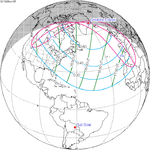 Partial |
1.1287 | ||||
Saros 126
[edit]This eclipse is a part of Saros series 126, repeating every 18 years, 11 days, and containing 72 events. The series started with a partial solar eclipse on March 10, 1179. It contains annular eclipses from June 4, 1323 through April 4, 1810; hybrid eclipses from April 14, 1828 through May 6, 1864; and total eclipses from May 17, 1882 through August 23, 2044. The series ends at member 72 as a partial eclipse on May 3, 2459. Its eclipses are tabulated in three columns; every third eclipse in the same column is one exeligmos apart, so they all cast shadows over approximately the same parts of the Earth.
The longest duration of annularity was produced by member 11 at 6 minutes, 30 seconds on June 26, 1359, and the longest duration of totality was produced by member 45 at 2 minutes, 36 seconds on July 10, 1972. All eclipses in this series occur at the Moon’s descending node of orbit.[11]
| Series members 36–57 occur between 1801 and 2200: | ||
|---|---|---|
| 36 | 37 | 38 |
 April 4, 1810 |
 April 14, 1828 |
 April 25, 1846 |
| 39 | 40 | 41 |
 May 6, 1864 |
 May 17, 1882 |
 May 28, 1900 |
| 42 | 43 | 44 |
 June 8, 1918 |
 June 19, 1936 |
 June 30, 1954 |
| 45 | 46 | 47 |
 July 10, 1972 |
 July 22, 1990 |
 August 1, 2008 |
| 48 | 49 | 50 |
 August 12, 2026 |
 August 23, 2044 |
 September 3, 2062 |
| 51 | 52 | 53 |
 September 13, 2080 |
 September 25, 2098 |
 October 6, 2116 |
| 54 | 55 | 56 |
 October 17, 2134 |
 October 28, 2152 |
 November 8, 2170 |
| 57 | ||
 November 18, 2188 | ||
Metonic series
[edit]The metonic series repeats eclipses every 19 years (6939.69 days), lasting about 5 cycles. Eclipses occur in nearly the same calendar date. In addition, the octon subseries repeats 1/5 of that or every 3.8 years (1387.94 days). All eclipses in this table occur at the Moon's descending node.
| 22 eclipse events between March 27, 1884 and August 20, 1971 | ||||
|---|---|---|---|---|
| March 27–29 | January 14 | November 1–2 | August 20–21 | June 8 |
| 108 | 110 | 112 | 114 | 116 |
 March 27, 1884 |
 August 20, 1895 |
 June 8, 1899 | ||
| 118 | 120 | 122 | 124 | 126 |
 March 29, 1903 |
 January 14, 1907 |
 November 2, 1910 |
 August 21, 1914 |
 June 8, 1918 |
| 128 | 130 | 132 | 134 | 136 |
 March 28, 1922 |
 January 14, 1926 |
 November 1, 1929 |
 August 21, 1933 |
 June 8, 1937 |
| 138 | 140 | 142 | 144 | 146 |
 March 27, 1941 |
 January 14, 1945 |
 November 1, 1948 |
 August 20, 1952 |
 June 8, 1956 |
| 148 | 150 | 152 | 154 | |
 March 27, 1960 |
 January 14, 1964 |
 November 2, 1967 |
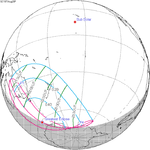 August 20, 1971 | |
Tritos series
[edit]This eclipse is a part of a tritos cycle, repeating at alternating nodes every 135 synodic months (≈ 3986.63 days, or 11 years minus 1 month). Their appearance and longitude are irregular due to a lack of synchronization with the anomalistic month (period of perigee), but groupings of 3 tritos cycles (≈ 33 years minus 3 months) come close (≈ 434.044 anomalistic months), so eclipses are similar in these groupings.
| Series members between 1801 and 2200 | ||||
|---|---|---|---|---|
 April 14, 1809 (Saros 116) |
 March 14, 1820 (Saros 117) |
 February 12, 1831 (Saros 118) |
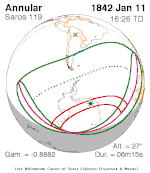 January 11, 1842 (Saros 119) |
 December 11, 1852 (Saros 120) |
 November 11, 1863 (Saros 121) |
 October 10, 1874 (Saros 122) |
 September 8, 1885 (Saros 123) |
 August 9, 1896 (Saros 124) |
 July 10, 1907 (Saros 125) |
 June 8, 1918 (Saros 126) |
 May 9, 1929 (Saros 127) |
 April 7, 1940 (Saros 128) |
 March 7, 1951 (Saros 129) |
 February 5, 1962 (Saros 130) |
 January 4, 1973 (Saros 131) |
 December 4, 1983 (Saros 132) |
 November 3, 1994 (Saros 133) |
 October 3, 2005 (Saros 134) |
 September 1, 2016 (Saros 135) |
 August 2, 2027 (Saros 136) |
 July 2, 2038 (Saros 137) |
 May 31, 2049 (Saros 138) |
 April 30, 2060 (Saros 139) |
 March 31, 2071 (Saros 140) |
 February 27, 2082 (Saros 141) |
 January 27, 2093 (Saros 142) |
 December 29, 2103 (Saros 143) |
 November 27, 2114 (Saros 144) |
 October 26, 2125 (Saros 145) |
 September 26, 2136 (Saros 146) |
 August 26, 2147 (Saros 147) |
 July 25, 2158 (Saros 148) |
 June 25, 2169 (Saros 149) |
 May 24, 2180 (Saros 150) |
 April 23, 2191 (Saros 151) | ||||
Inex series
[edit]This eclipse is a part of the long period inex cycle, repeating at alternating nodes, every 358 synodic months (≈ 10,571.95 days, or 29 years minus 20 days). Their appearance and longitude are irregular due to a lack of synchronization with the anomalistic month (period of perigee). However, groupings of 3 inex cycles (≈ 87 years minus 2 months) comes close (≈ 1,151.02 anomalistic months), so eclipses are similar in these groupings.
| Series members between 1801 and 2200 | ||
|---|---|---|
 August 28, 1802 (Saros 122) |
 August 7, 1831 (Saros 123) |
 July 18, 1860 (Saros 124) |
 June 28, 1889 (Saros 125) |
 June 8, 1918 (Saros 126) |
 May 20, 1947 (Saros 127) |
 April 29, 1976 (Saros 128) |
 April 8, 2005 (Saros 129) |
 March 20, 2034 (Saros 130) |
 February 28, 2063 (Saros 131) |
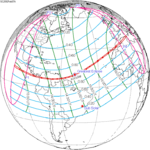 February 7, 2092 (Saros 132) |
 January 19, 2121 (Saros 133) |
 December 30, 2149 (Saros 134) |
 December 9, 2178 (Saros 135) |
|
Notes
[edit]- ^ "June 8–9, 1918 Total Solar Eclipse". timeanddate. Retrieved 1 August 2024.
- ^ "Moon Distances for London, United Kingdom, England". timeanddate. Retrieved 1 August 2024.
- ^ a b Motherwell, R.M. (1918). "The Total Solar Eclipse, June 8, 1918". Journal of the Royal Astronomical Society of Canada. 12: 160–168A. Bibcode:1918JRASC..12..160M.
- ^ a b Hammond, J.C. (1919). "The Naval Observatory eclipse expedition, June 8, 1918". Popular Astronomy. 27 (1): 1. Bibcode:1919PA.....27....1H.
- ^ a b Lawrence, Jenny; Richard Milner (February 2000). "A Forgotten Cosmic Designer". Natural History. Retrieved 19 October 2010.
- ^ Stebbins, Joel (1918). "The Illinois eclipse expedition to Rock Springs Wyoming". Popular Astronomy. 26: 665. Bibcode:1918PA.....26..665S.
- ^ "Total Solar Eclipse of June 8, 1918". Nature. 102 (2553): 89–90. 3 October 1918. Bibcode:1918Natur.102...89.. doi:10.1038/102089a0.
- ^ Siegel, Ethan (2007). "America's Previous Coast-To-Coast Eclipse Almost Proved Einstein Right", Forbes, August 4, 2017, retrieved 24 April 2022.
- ^ "Total Solar Eclipse of 1918 Jun 08". EclipseWise.com. Retrieved 1 August 2024.
- ^ van Gent, R.H. "Solar- and Lunar-Eclipse Predictions from Antiquity to the Present". A Catalogue of Eclipse Cycles. Utrecht University. Retrieved 6 October 2018.
- ^ "NASA - Catalog of Solar Eclipses of Saros 126". eclipse.gsfc.nasa.gov.
Other links
[edit]- NASA graphic
- Eclipse of June 8, 1918. Contact print from the original glass plate negative. Lick Observatory Plate Archive, Mt. Hamilton.
- Foto and sketch of Solar Corona June 8, 1918

